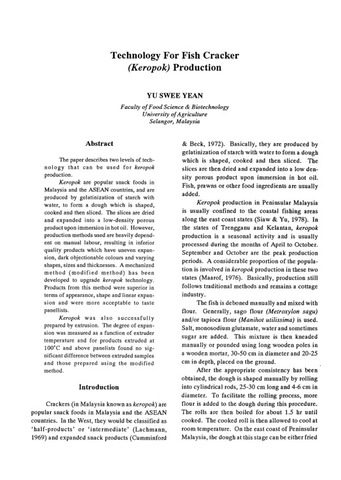Technology for fish cracker (keropok) production
Share
Abstract
The paper describes two levels of technology that can be used for keropok production.
Keropok are popular snack foods in Malaysia and the ASEAN countries, and are produced by gelatinization of starch with water, to form a dough which is shaped, cooked and then sliced. The slices are dried and expanded into a low-density porous product upon immersion in hot oil. However, production methods used are heavily dependent on manual labour, resulting in inferior quality products which have uneven expansion, dark objectionable colours and varying shapes, sizes and thicknesses. A mechanized method (modified method) has been developed to upgrade keropok technology. Products from this method were superior in terms of appearance, shape and linear expansion and were more acceptable to taste panellists.
Keropok was also successfully prepared by extrusion. The degree of expansion was measured as a function of extruder temperature and for products extruded at 100°C and above panelists found no significant difference between extruded samples and those prepared using the modified method.
Suggested Citation
Yu, S. Y. (1991). Technology for fish cracker (keropok) production. In K. K. Hooi, K. Miwa, & M. B. Salim (Eds.), Proceedings of the Seminar on Advances in Fishery Post-Harvest Technology in Southeast Asia: Singapore, 6-11 May, 1991 (pp. 143-150). Singapore: Marine Fisheries Research Department, Southeast Asian Fisheries Development Center.

